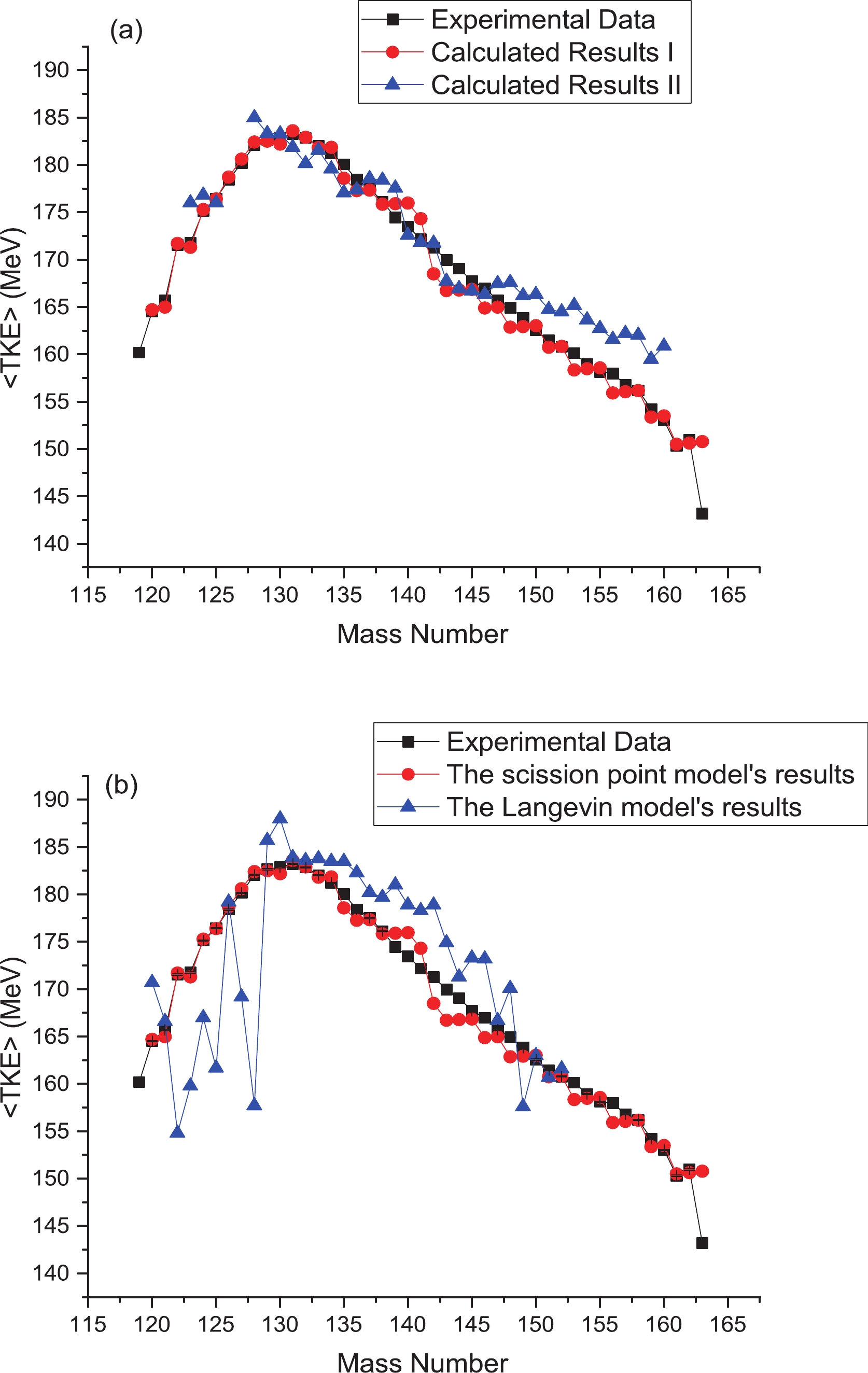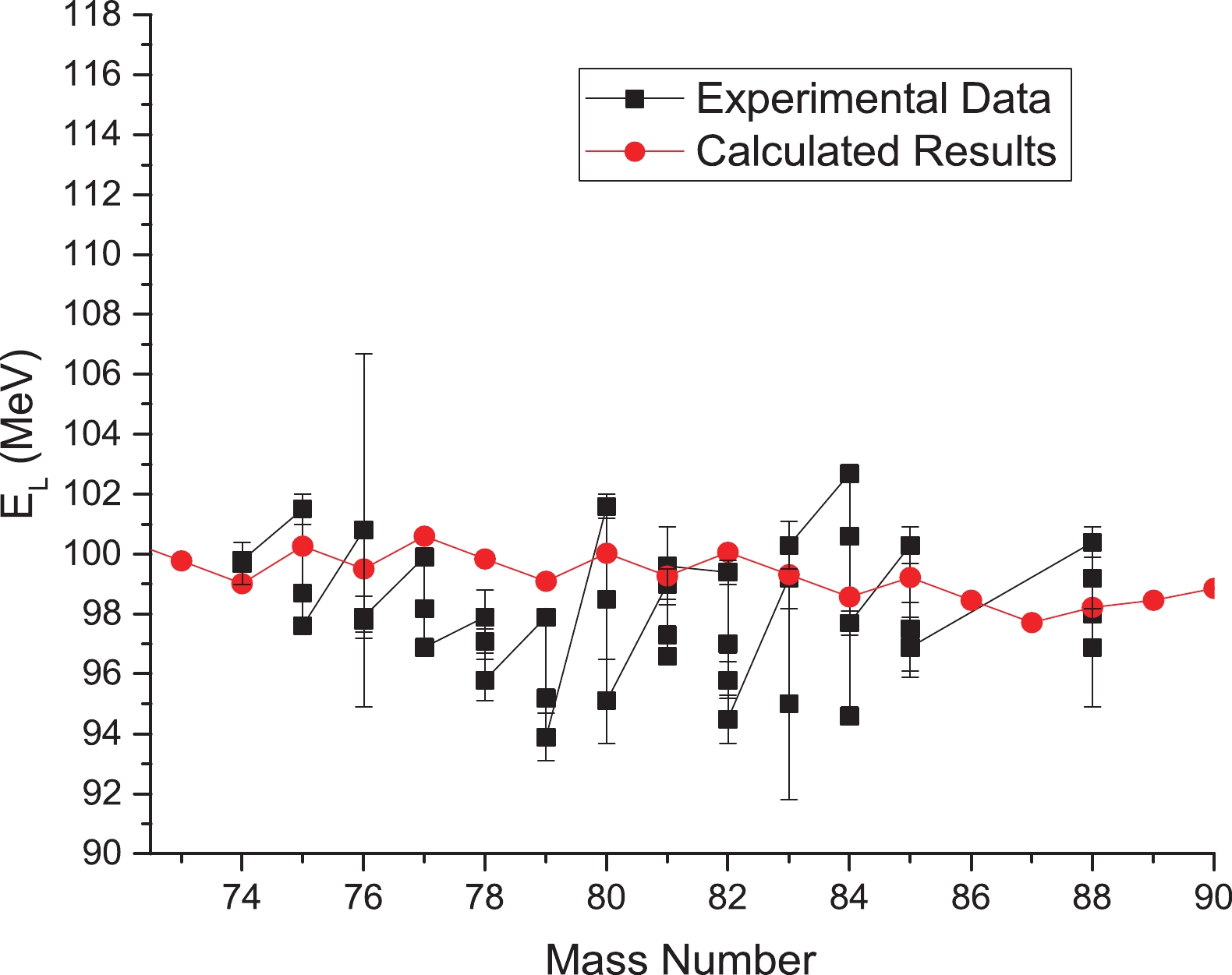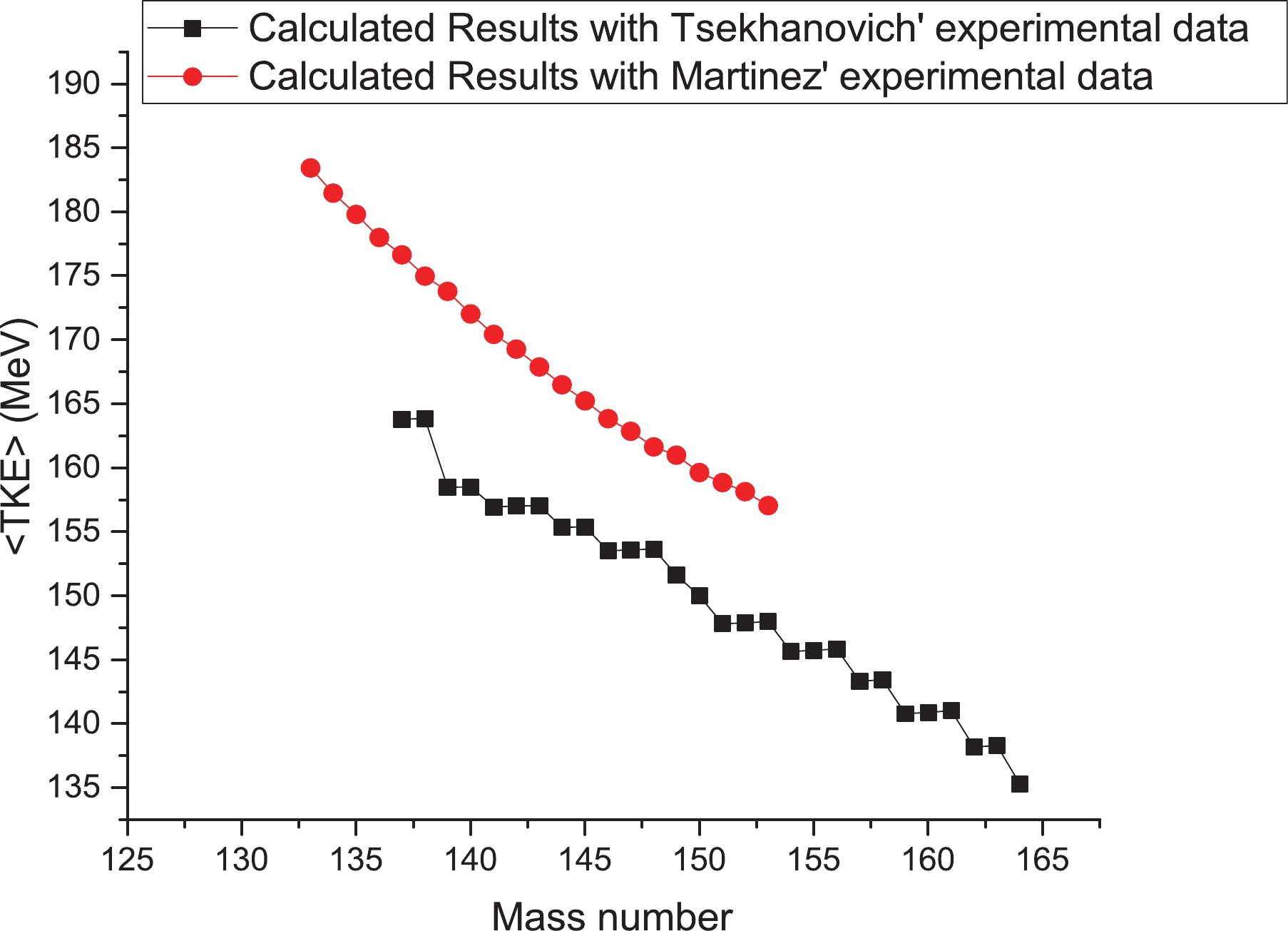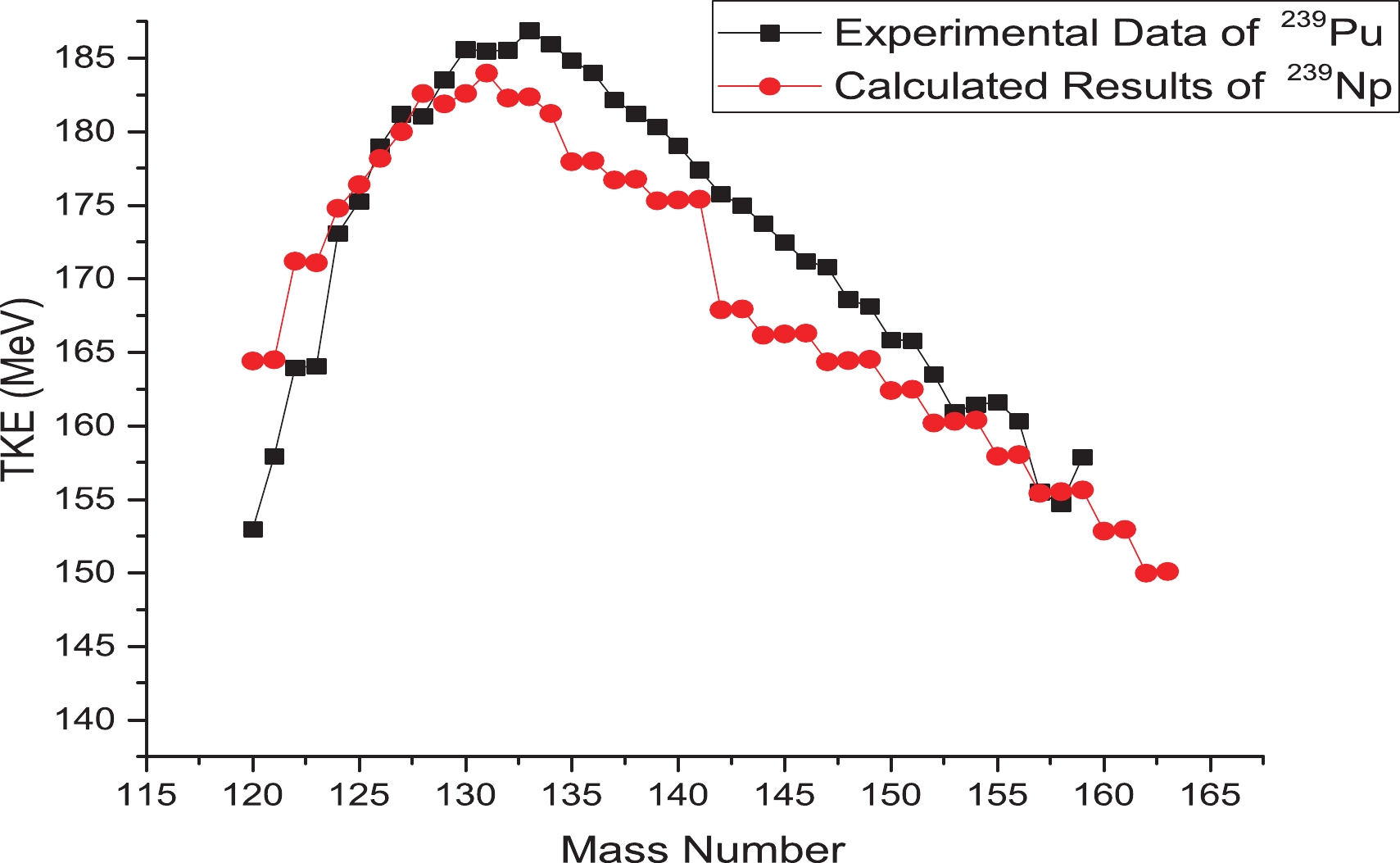HTML
--> --> -->There has been little theoretical work on different methods to calculate fission total kinetic energy (TKE) [31-36]. None of them has studied the fission of neptunium isotopes. Ivanyuk [37, 38] has calculated deformation energy with the two-center shell model parameterization and has estimated TKE and total excitation energy (TXE) of fission fragments in a quasi-static approximation. Some researchers, such as Morariu [39], have calculated TXE using TKE. Ruben [40] presented the two spheroid model (TSM) model for calculating TXE and TKE, but in that work, TKE was calculated with the prescission energy which was approximated by Ref. [41]. A similar model, presented recently by Adamian [42], is the dinuclear system, in which two near-touching coaxial nuclei are assumed at a particular scission point while their volume is conserved. With this model, Andreev [43] obtained the fine structure in the TKE of neutron-induced fission fragments. In this formalism, the TKE distribution is calculated with Coulomb energy and nuclear energy.
The TSM model is a scission point model in which the scission configuration is assumed to consist of two spheroidal fragments. In this model, two spheres are separated by a distance d
This article is organized as follows. In Section II, the calculation framework is presented. In the next section, the calculated results are compared with the experimental data and two other methods. Then, the deformation parameters are discussed at the scission point. In Section IV, the TKE distributions are studied for neutron-induced fission of odd/even nuclei, especially for the <TKE> distribution of neutron-induced fission of
$ TKE(A_{i},\beta_{i}) = V_{\rm coul}(A_{L}/A_{H},\beta_{i},d) +V_{\rm nuc}(A_{L}/A_{H},\beta_{i},d), $  | (1) |
The Coulomb energy is defined by [32]
$\begin{aligned}[b] V_{\rm coul} =& {\frac { Z_L \, Z_H \, e^2}{D}} \left( 1+ 0.3785\,{\frac {R_2^2 \beta_2 + R_1^2 \, \beta_1}{D^2}} \\&+0.3164\,{\frac {R_1^2{\beta_1^2}+{R_2^2}\beta_2^2}{D ^2}}+ 0.20472\,{\frac {R_1^ 4{\beta_1^2}+{R_2^4} {\beta_2^2}}{D^4}}\\&\left.+ 0.8598\,{\frac {R_1^2 {R_2^2} {\beta1}\,{\beta2}}{D ^4}} \right),\end{aligned}$  | (2) |
$ V_{\rm prox}(d) = 4 \pi \gamma b \left[\frac{C_1 C_2}{C_1+ C_2}\right] \Phi(\varepsilon) , \qquad \left(\varepsilon = \frac{d}{b}\right), $  | (3) |
$ \gamma = 0.9517\sqrt{(1-2.61I_{1}^2)(1-2.61I_{2}^2)} \quad {\rm MeV/fm^2}, \qquad $  | (4) |
$ I_i = \frac{(N_i-Z_i)}{A_i}, $  | (5) |
$ C_{i} = R_{i}-\left[\frac{b^2}{R_{i}} \right], $  | (6) |
$ R_i({\rm fm}) = 1.28R_{0,i}-0.76+0.8 R_{0,i}^{-1}, $  | (7) |
$ R_{0,i}(\theta) = R_0(1+\beta_iY_{20}(\theta_i)), $  | (8) |
In Eq. (3), the universal proximity relation
$ \Phi (\varepsilon ) = \left\{ {\begin{array}{*{20}{l}}{ - 1.7817 + 0.9270\varepsilon + 0.0169{\varepsilon ^2} - 0.0514{\varepsilon ^3}}\\{\qquad {\rm{for}}\quad 0 \leqslant \varepsilon \leqslant 1.9475},\\{ - 4.41\exp ( - \varepsilon /0.7176)}\\{\qquad {\rm{for}}\quad \varepsilon \geqslant 1.9475.}\end{array}} \right.$  | (9) |
$ Z_{\rm UCD} = {\frac {{\it Z_{cn}}\,{\it (A+ \nu})}{{\it A_{cn}}}}, $  | (10) |
$ TKE = E_{L} {\frac{{\it A_{cn}}}{{\it A_{H}}}}. $  | (11) |
The calculated <TKE> values from the two methods for the neutron-induced fission of
 Figure1. (color online) (a) Calculated mean total kinetic energy as a function of fragment mass for neutron-induced fission of
Figure1. (color online) (a) Calculated mean total kinetic energy as a function of fragment mass for neutron-induced fission of   |   |   |   |
| 120 | 0.86 | 128 | 0.47 |
| 121 | 0.85 | 129 | 0.47 |
| 122 | 0.69 | 130 | 0.46 |
| 123 | 0.69 | 131 | 0.44 |
| 124 | 0.61 | 132 | 0.45 |
| 125 | 0.58 | 133-135 | 0.45 |
| 126 | 0.54 | 135-142 | 0.5 |
| 127 | 0.51 | 142-170 | 0.65 |
Table1.Change in
The second method of calculation (calculated results II) is based on Ref. [53]. There is good agreement between the results from this model and experimental data for fission fragments with mass numbers greater than
$ \begin{aligned}[b] TKE(A_{L}/A_{H})\approx & E_{\rm Coul}(A_{L}/A_{H})+E_{\rm shell}(A_{L},A_{H}) \\&+\Delta(A_{L},A_{H})-E_{\rm def}(A_{L},A_{H})+C_{cn}, \end{aligned} $  | (12) |
$ \alpha = \left\{ {\begin{array}{*{20}{l}}{5 + 0.4|{A_i} - 135|\qquad {\rm{for}}\qquad 125 < {A_i} < 140},\\{4.86 - 0.063{\mkern 1mu} \dfrac{{{Z^2}}}{A}\qquad {\rm{for}}\qquad {\rm{other}}.}\end{array}} \right. $  | (13) |
In Fig. 1(b), the calculated results of the scission point model and the Langevin model are compared with the experimental results. For fission fragments with mass numbers greater than 133, the results of both models are in good agreement with the experimental results. For fission fragments with mass numbers less than 133, however, there are large variations in <TKE> values for the results calculated with the Langevin model. These large variations can also be seen in some of the experimental results; this is related to the influence of target thickness, according to Gook [55]. Of course, the <TKE> results calculated with the scission point model are close to the experimental data because the experimental data are reproduced by fitting the
In Fig. 2, the mean kinetic energy values (
 Figure2. (color online) Calculated mean kinetic energy of light fragment
Figure2. (color online) Calculated mean kinetic energy of light fragment  Figure3. (color online) Calculated <TKE> as a function of heavy fission fragment mass number, using the experimental data for total kinetic energy of light fission fragments (Tsekhanovich [16] and Martinez [56]) for neutron-induced fission of
Figure3. (color online) Calculated <TKE> as a function of heavy fission fragment mass number, using the experimental data for total kinetic energy of light fission fragments (Tsekhanovich [16] and Martinez [56]) for neutron-induced fission of By fitting the calculated results to the experimental data, the deformation parameters of light fission fragments are presented for neutron-induced fission of
  |   |
| 74-89 | 0.9 |
| 89-100 | 0.85 |
| 100-105 | 0.75 |
Table2.Change in
  |   |   |   | |
| 85-89 | 0.66 | 97 | 0.58 | |
| 89-93 | 0.64 | 98 | 0.56 | |
| 94 | 0.57 | 99 | 0.64 | |
| 95 | 0.61 | 100-105 | 0.52 | |
| 96 | 0.56 |
Table3.Change in
Martinez [56] has measured the average kinetic energy values for fission of
 Figure4. (color online) (a) Comparison of experimental values of total kinetic energy for neutron-induced fission of
Figure4. (color online) (a) Comparison of experimental values of total kinetic energy for neutron-induced fission of Furthermore, it is seen that the <TKE> values of odd-odd or even-even fissioning systems are greater than the <TKE> values of even-odd or odd-even fissioning systems. Also, the behavior of the <TKE> distribution for neutron-induced fission of odd-odd and even-even fissioning systems is the same. For example, the <TKE> values for neutron-induced fission of
In Fig. 4(b), the experimental values of <TKE> for neutron-induced fission of nuclei with mass number 238 are compared. The experimental data for neutron-induced fission of
 Figure5. (color online) (a) <TKE> distribution for neutron-induced fission of experimental data for
Figure5. (color online) (a) <TKE> distribution for neutron-induced fission of experimental data for  Figure6. (color online) Calculated <TKE> as a function of fragment mass number for neutron-induced fission of
Figure6. (color online) Calculated <TKE> as a function of fragment mass number for neutron-induced fission of  Figure7. (color online) Calculated <TKE> as a function of fragment mass number for neutron-induced fission of
Figure7. (color online) Calculated <TKE> as a function of fragment mass number for neutron-induced fission of The <TKE> distribution for neutron-induced fission of
In Fig. 5(b), the <TKE> distribution for neutron-induced fission of
In Fig. 6, the <TKE> distribution for neutron-induced fission of
In Fig. 7, the calculated <TKE> values for neutron-induced fission of
The results of this method have been compared with the results of other methods, showing that the best results are obtained using the scission point model. There are some dramatic variations in some experimental data, which may be due to kinetic energy measurements after prompt neutron decay.
Also, it is seen that the <TKE> values of odd-odd or even-even fissioning systems is greater than the <TKE> values of even-odd or odd-even fissioning systems. This increase in <TKE> values for neutron-induced fission of nuclei with odd mass numbers, compared with those of nuclei with even mass numbers, does not depend on the atomic number being even or odd. It means this increase in <TKE> values is not related to the odd atomic number of the nuclei, but to the odd mass number.


